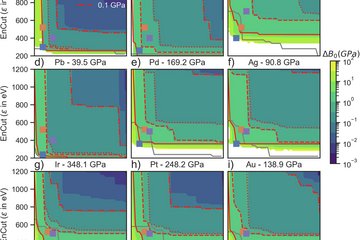All genres
561.
Journal Article
New insights into the austenitization process of low-alloyed hypereutectoid steels: Nucleation analysis of strain-induced austenite formation. Acta Materialia 80, pp. 296 - 308 (2014)
562.
Journal Article
Interfacial dislocation motion and interactions in single-crystal superalloys. Acta Materialia 79, pp. 216 - 233 (2014)
563.
Journal Article
Smaller is less stable: Size effects on twinning vs. transformation of reverted austenite in TRIP-maraging steels. Acta Materialia 79, pp. 268 - 281 (2014)
564.
Journal Article
Elemental partitioning and mechanical properties of Ti- and Ta-containing Co–Al–W-base superalloys studied by atom probe tomography and nanoindentation. Acta Materialia 78, pp. 78 - 85 (2014)
565.
Journal Article
Composition Dependance of Phase Stability, Deformation Mechanisms, and Mechanical Properties of the CoCrFeMaNi High-Entropy Alloy System. JOM 66 (10), pp. 1993 - 2001 (2014)
566.
Journal Article
Structure of rapidly quenched (Cu0.5Zr0.5)100-xAgx alloys (x=0-40 at.%). Journal of Alloys and Compounds 607, pp. 285 - 290 (2014)
567.
Journal Article
Precipitation and austenite reversion behavior of a maraging steel produced by selective laser melting. Journal of Materials Research 29 (17), pp. 2072 - 2079 (2014)
568.
Journal Article
Segregation stabilizes nanocrystalline bulk steel with near theoretical strength. Physical Review Letters 113 (10), 106104 (2014)
569.
Journal Article
Ultrastructural organization and micromechanical properties of shark tooth enameloid. Acta Biomaterialia 10 (9), pp. 3959 - 3968 (2014)
570.
Journal Article
Texture and microstructure evolution during non-crystallographic shear banding in a plane strain compressed Cu–Ag metal matrix composite. Acta Materialia 76, pp. 238 - 251 (2014)
571.
Journal Article
Designing Heusler nanoprecipitates by elastic misfit stabilization in Fe–Mn maraging steels. Acta Materialia 76, pp. 94 - 105 (2014)
572.
Journal Article
Texture Evolution as Determined by In situ Neutron Diffraction During Annealing of Iron Deformed by Equal Channel Angular Pressing. Metallurgical and Materials Transactions a-Physical Metallurgy and Materials Science 45A (10), pp. 4235 - 4246 (2014)
573.
Journal Article
Large recovery strain in Fe–Mn–Si-based shape memory steels obtained by engineering annealing twin boundaries. Nature Communications 5, 4964 (2014)
574.
Journal Article
Designing quadplex (four-phase) microstructures in an ultrahigh carbon steel. Materials Science and Engineering A: Structural Materials Properties Microstructure and Processing 612, pp. 46 - 53 (2014)
575.
Journal Article
Impact of nanodiffusion on the stacking fault energy in high-strength steels. Acta Materialia 75, pp. 147 - 155 (2014)
576.
Journal Article
Shear-induced mixing governs codeformation of crystalline-amorphous nanolaminates (Erratum: Physical Review Letters (2014) 113 (035501)). Physical Review Letters 113 (6), 069903 (2014)
577.
Journal Article
Atom probe tomography observation of hydrogen in high-Mn steel and silver charged via an electrolytic route. International Journal of Hydrogen Energy 39 (23), pp. 12221 - 12229 (2014)
578.
Journal Article
Grain boundary segregation engineering in metallic alloys: A pathway to the design of interfaces. Current Opinion in Solid State and Materials Science 18 (4), pp. 253 - 261 (2014)
579.
Journal Article
Superplastic Mn–Si–Cr–C duplex and triplex steels: Interaction of microstructure and void formation. Materials Science and Engineering A: Structural Materials Properties Microstructure and Processing 610, pp. 355 - 369 (2014)
580.
Journal Article
Multiple reentrant glass transitions in confined hard-sphere glasses. Nature Communications 5, 4435 (2014)











